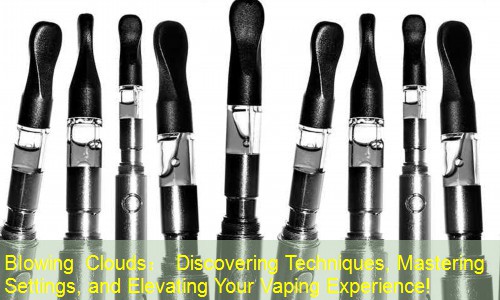The Art and Science of Cloud Production in Vaping

In recent years, the popularity of vaping has surged, particularly within communities that prioritize both flavor and cloud production. The pursuit of large clouds consists not only of the device used but also the skilled techniques employed by enthusiasts. This article will delve into several key numerical factors that contribute to the art of producing impressive vapor clouds, covering aspects such as wattage, e-liquid composition, coil resistance, and airflow settings.
1. Wattage: Finding the Optimal Range
One of the primary metrics for cloud production is wattage. Vaping devices typically offer a range of power settings, often from 5 to over 200 watts. Most cloud chasers operate within the range of 60 to 120 watts. At these levels, the increased energy facilitates the rapid vaporization of e-liquids, resulting in substantial cloud formation. However, exceeding 120 watts can lead to diminished returns, where the heat may cause a loss in flavor quality while potentially shortening coil lifespan.
2. E-Liquid Composition: The PG-VG Ratio
The base composition of e-liquids significantly influences vapor production. Propylene Glycol (PG) and Vegetable Glycerin (VG) are the primary components, and adjusting their ratios is critical for achieving dense clouds. A common ratio is 70% VG to 30% PG, as this combination strikes a balance between flavor and cloud density. VG, being thicker and more viscous, is responsible for producing larger clouds, whereas PG enhances flavor and throat hit.
3. Coil Resistance: Understanding Ohm Ratings
Coil resistance is another crucial factor in cloud production. Measured in ohms, the resistance of a coil can vary widely, generally falling between 0.1 to 2.0 ohms. Lower resistance coils (sub-ohm) allow for higher current flow, producing more vapor at lower wattages. A sub-ohm coil of around 0.15 to 0.3 ohms is widely favored among cloud chasers for delivering voluminous vapor. However, it is essential to pair these coils with devices capable of handling such resistances to ensure safety and efficiency.
4. Airflow Settings: A Critical Balance
Airflow settings considerably affect the amount of vapor produced. Devices often feature adjustable airflow options that range from restrictive to wide open. A wider airflow setting facilitates larger clouds by allowing more air to mix with the vapor, enhancing cloud density. A common setup for cloud enthusiasts is to fully open the airflow, promoting an airy draw that supports voluminous vapor release. However, this can also dilute flavor; thus, finding a personal balance between flavor and vapor is essential.
5. Technique: The Importance of Draw Method
The technique of inhalation plays a pivotal role in cloud production. Common methods involve the direct lung (DL) hit, which allows for a more substantial amount of vapor to be inhaled at once compared to a mouth-to-lung (MTL) method. Vapers seeking maximum cloud output typically favor the DL hit, which involves taking a deep breath directly from the device without holding the vapor in the mouth first. Understanding the breathing pattern and timing can enhance the overall experience and increase cloud yield.
6. Temperature Control: The Impact on Vapor Density
Utilizing temperature control (TC) settings is advantageous for experienced users aiming for consistent cloud production. By controlling the temperature of the coils, vapers can prevent burning and produce a smoother vapor. Most vaping devices with TC capabilities allow users to set a specific temperature, often between 350°F and 450°F. This precise control helps in maintaining optimal vaporization of the e-liquid, allowing for consistent cloud density.
7. Device Selection: Choosing the Right Tools
The type of device employed plays a fundamental role in cloud creation. A wide array of options, including sub-ohm tanks and rebuildable dripping atomizers (RDAs), cater to cloud production enthusiasts. Sub-ohm tanks are convenient, while RDAs provide customization potential through the building of coils. Selecting a device that matches one’s vaping style, preferences, and skill level is essential for maximizing cloud output.
Conclusion
The journey toward mastering cloud production is multifaceted, requiring an understanding of several numerical factors that influence vapor density. By carefully considering wattage, e-liquid composition, coil resistance, airflow settings, inhalation techniques, temperature control, and device selection, enthusiasts can refine their vaping experience. Each component must work synergistically to maximize vape clouds while balancing flavor and safety. As the vaping community continues to evolve, knowledge sharing and experimentation remain pivotal to achieving breathtaking clouds.














